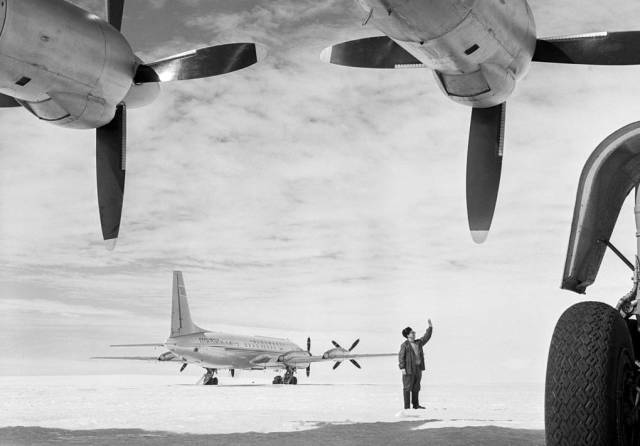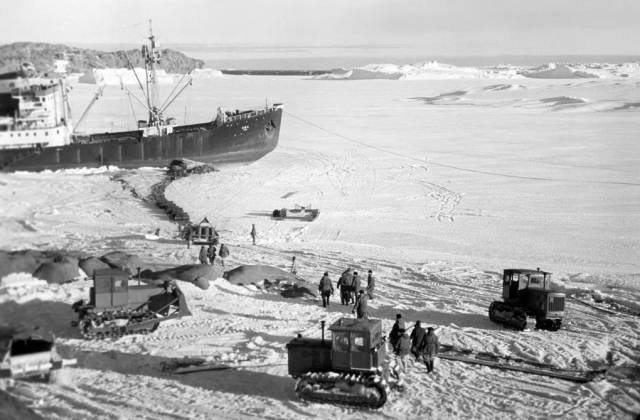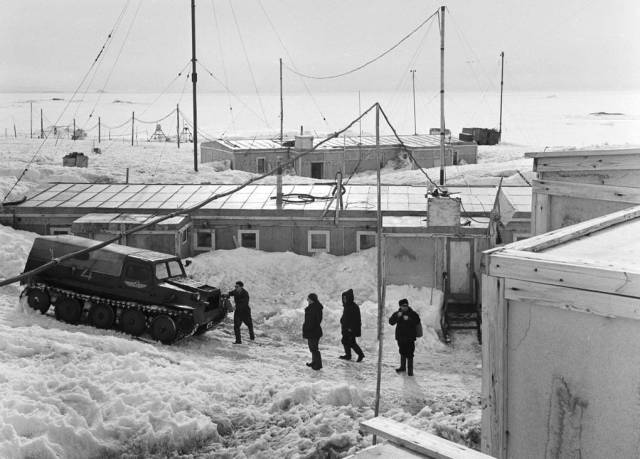Dmitry Khazanov - about how the USSR began studying the sixth continent, as well as what and who hindered him in this
Aviation has played an extremely important role in the development of polar latitudes. At the same time, some achievements of the past seem incredible even today. For example, during the ice exploration in Antarctica on March 18, 1957, 65 years ago, the commander of the naval expedition squadron, Hero of the Soviet Union Ilya Mazuruk and pilot Alexander Polyakov on an An-2 aircraft landed on the top of an iceberg for the first time.

Soviet aircraft of polar aviation at the Antarctic scientific station "Mirny"
Image source: © Sergey Preobrazhensky/TASS
This anniversary, in my opinion, is an excellent occasion to remember how the development of the sixth continent by our compatriots began. Brave polar explorers, who were primarily engaged in studying the Arctic, the Russian North, did not immediately begin Antarctic flights.
Is the territory divided?
The first documented case of a man landing on the ice of Antarctica occurred on January 24, 1895. Then three Norwegians and a New Zealander collected rocks of the continent, and also discovered vegetation - lichens. Researchers were amazed that living organisms can live and reproduce in such a harsh climate. Soon began a real boom in the study of the sixth continent, which in history is known as the "heroic age of Antarctic research." From 1897 to 1922, 16 international expeditions were organized, in which 19 people died. In 1929, American Richard Byrd flew an airplane over the South Pole, which no one was able to repeat for the next 27 years.
Soviet work in Antarctica began only in 1946, when the Slava whaling flotilla with a group of scientists on board entered its waters. Oceanographic studies were also conducted from ships along the way. But Western countries wanted to push back our specialists - they say, the territory is already divided among those who came earlier.
In response, in June 1950, the Soviet government stated that "it cannot recognize as legitimate any decision on the Antarctic regime taken without its participation." Recalling that it was the Russian navigators who discovered the mainland in an expedition led by Thaddeus Bellingshausen and Mikhail Lazarev on the sloops Vostok and Mirny in 1820. Some other measures were taken against discrimination of the Soviet Union. When US President Harry Truman's Secretary of State James Byrnes, who always advocated the toughest sanctions against the USSR, unexpectedly resigned, he finally responded about Antarctica and our claims: "It turned out impossible to scare the damned Russians. They won on this issue."
After agreeing on organizational issues, at the Paris Conference on the preparation of the International Geophysical Year in 1955, the Soviet representative announced that the USSR planned to build stations at the Southern Geomagnetic Pole and the Pole of Inaccessibility, as well as a support base on the Shore of the Knox. On July 13 of the same year, the Council of Ministers of the USSR issued a resolution on the organization of the first Integrated Antarctic Expedition (KAE).
The first expedition of the Union
The scientific management of the work was entrusted to the Academy of Sciences of the USSR, which selected specialists from those who had experience in the Arctic. Initially, twice Hero of the Soviet Union Ivan Papanin wanted to lead the expedition, but doctors did not allow the 61-year-old polar explorer to go to the extreme south of the planet. Then the famous geographer Viktor Buinitsky was going to be appointed to the post of head of the first KAE, but the 43-year-old scientist had a heart attack. As a result, the research began under the supervision of the Deputy director of the Arctic Research Institute, Hero of the Soviet Union Mikhail Somov.
The pioneers were faced with the task of organizing the main coastal base, choosing places for the creation of future inland stations, starting work in the interior of the mainland using land transport and aviation, and conducting comprehensive oceanological research in the Indian sector of Antarctic waters. The expedition was prepared in a hurry, the conditions that the group would face on the spot were not sufficiently thought out and taken into account (although few people imagined these conditions at that time). The training was conducted as for work in the Arctic, without taking into account the fact that in Antarctica, as polar explorers joked later, "everything is the opposite."
The IL-12 aircraft before landing at the airfield of the Mirny station as part of the first Integrated Antarctic Expedition
Image source: © Alexander Kochetkov/TASS
Three months passed, and on November 30, 1955, a diesel-electric ship "Ob", converted into a research vessel, left Kaliningrad in the direction of Antarctica. There were three aircraft on board - Il-12D (amphibious), Li-2T (transport) and An-2, as well as a Mi-1 helicopter. Thus began the first Soviet KAE.
Two weeks later, the Lena diesel-electric ship and Refrigerator No. 7 with 4 thousand tons of cargo, a Li-2 aircraft and two Mi-4 helicopters headed for the sixth continent along the same route. In total, the polar explorers received seven boards equipped and several modified for flights in harsh climatic conditions. Ivan Cherevichny, an experienced polar explorer, was assigned to command an expeditionary squadron consisting of 21 people.
Difficulties from nature
Immediately after unloading from the diesel-electric ship, it turned out that due to confusion during loading, containers with helicopter parts ended up on different ships. For example, during assembly, the absence of wheels was found. The aviators decided not to wait for supplies and to adapt the wheels from the An-2 aircraft for the Mi-1, and to make other missing parts in the workshops of Obi. On January 8, 1956, a Soviet helicopter took to the skies of Antarctica for the first time. But the very next day a strong storm began, which lasted for three days.
Ivan Cherevichny, head of the aviation squadron
As soon as the weather allowed, pilot Alexey Kash on an An-2 aircraft with several scientists on board made the first reconnaissance flight in order to find a place for the construction of the first Soviet Antarctic station. During the inspection of the coast between the ice shelves, they could not find a suitable place for construction for a long time. Only on January 14, it was possible to find a suitable site in the area of the Haswell Islands, 4 km from the edge of the solder. The landing to study the terrain in more detail was successful, but the plane could not take off from it - the terrible cold, the thinness of the air did not allow the engine to start (the engine power dropped). Fortunately, the crew was able to establish stable radio communication.

Unloading of the diesel-electric ship "Ob" during the first Complex Antarctic expedition
Image source: © Alexander Kochetkov/TASS
On the newly assembled Li-2, without stopping the engines after landing, Cherevichny took them on board. It became clear that the Li-2T and An-2 aircraft needed additional refinement for such harsh climatic conditions. In particular, it was necessary to equip aircraft (as well as ground tractors) with turbocharging to ensure the preservation of power. On January 16, Ivan Cherevichny also performed a reconnaissance flight along the coast, through the Shackleton ice shelf to the Knox Coast.
These initial sorties over the continent showed that the working conditions of aviation on the sixth continent will differ in many ways from the Arctic. For example, the starry sky looked completely different here - you will have to get used to working with astronomical and magnetic compasses in relation to the Southern hemisphere. If flights in the Arctic were carried out mainly over the water surface or ice fields at low altitudes, then in Antarctica, where mountain ranges rose to 4 thousand meters, flights will be high-altitude. Besides, there were no reliable maps of the area yet, they only had to be compiled.
Alexander Gusev, expedition member, MSU professor, mountaineer and meteorologist
After approaching the shores of Antarctica, the Lena diesel-electric ship and Refrigerator No. 7 began intensive unloading - for at least ten days, planes and helicopters transported hundreds of tons of cargo and people from the shore. The first Russian Antarctic settlement - 21 buildings and an airfield - was built in two months. On February 13, the flag of the USSR was raised on the Shore of Pravda over the Mirny station (named after the famous Russian sloop). It became the base point for further development of the continent. 92 people remained for the first winter in Mirny (1955-1956). That year our station became the largest in Antarctica. Flights deep into the continent began, where the Vostok station was soon founded.
The Second Antarctic
The tasks of the second Antarctic expedition (1956-1957) included the change of personnel of the first and the completion of the construction of the Mirny station, the creation of two more scientific stations in the interior of the continent in the area of the Southern geomagnetic Pole and in the area of the Pole of relative inaccessibility, the organization of a toboggan-tractor hike deep into the continent for glaciological (glacial) research. It was also necessary to begin a comprehensive study of the South polar waters. The Hero of Socialist Labor Alexey Treshnikov was assigned to direct the work of the second KAE. Three ships and 625 people were placed at his disposal, of which 189 were to stay for the winter. Among them was the American meteorologist Gordon Cartwright, who served the American section of the Alsib highway (Alaska - Siberia) during the Second World War on the transfer of Lend-Lease aircraft from the USA to the USSR.

Participants of the Soviet Antarctic scientific expedition on the territory of the Mirny station
Image source: © Viktor Koshevoy/TASS
In total, the pilots of the second KAE spent 3.4 thousand hours in the air, transported about 800 tons of cargo and made more than 300 landings on unprepared sites. At the same time, the polar pilots, together with employees of the hydrographic Department of the Northern Sea Route and Navy specialists, collected a large amount of information, on the basis of which the Atlas of Antarctica was first prepared and published.
The unique landing on the top of the iceberg took place on March 18, 1957. The possibility of landing aircraft on an ice floe drifting in the ocean was being worked out. Such experience could be useful on the mainland itself due to the peculiarities of its surface - frequent ditches and high hummocks, which required special concentration from the crews. Having shown courage and high professionalism, Ilya Mazuruk and Alexander Polyakov demonstrated the reliability and strength of our aviation equipment - they sat down flawlessly on a very limited improvised runway. Of course, not everyone could perform such an accurate calculation. Ilya Mazuruk had a lot of experience in very difficult flight conditions - he personally mastered the route from Alaska to Krasnoyarsk when he was the head of the Krasnoyarsk Air Route of the Air Force in the early war years. Even before the beginning of the Great Patriotic War, he held the post of head of the Polar Aviation Department of the Glavsevmorput.
Alexander Polyakov, after returning from the expedition, was appointed commander of the ship of the 254th flight detachment of polar aviation. And on December 15, 1961, an unprecedented flight of two planes began on the route Moscow - Antarctica with eight landings for refueling: across four continents and two oceans, 26,423 km were overcome. Having completed all the tasks, both ships returned home to Sheremetyevo on February 2, 1962. The commander of the leading Il-18 was Polyakov. Having laid the Moscow - Mirny highway and tested a turboprop liner on it, he was soon awarded the title of Hero of Socialist Labor (as was Boris Osipov, who flew the second aircraft, the An-12, which was considered cargo).
At the end of 1957, the third KAE of the famous scientist Evgeny Tolstikov arrived on the mainland, then all new groups of researchers were formed. To date, 37 Soviet and 27 Russian expeditions have worked in Antarctica, which made it possible to accumulate and summarize the huge material obtained by scientists.
